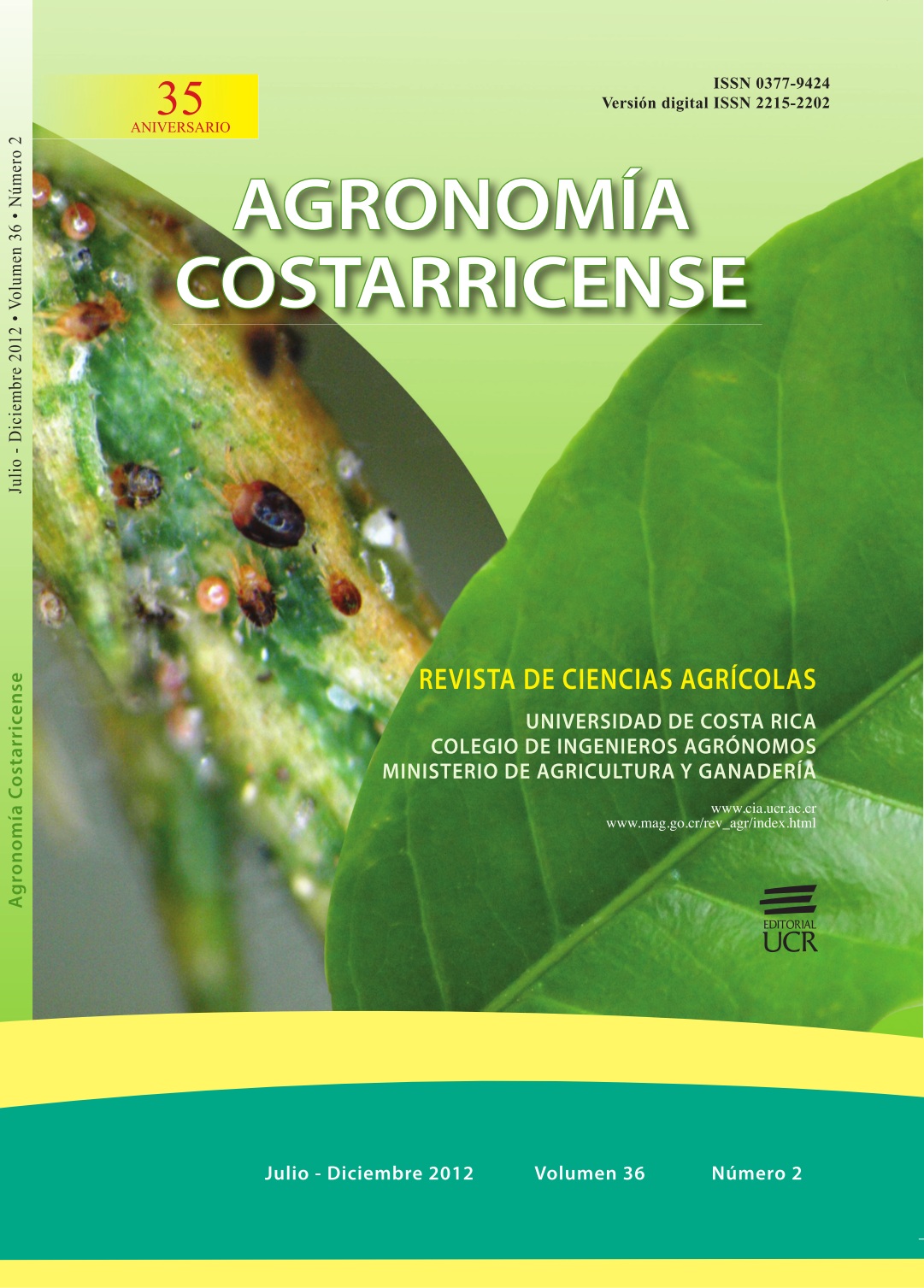Resumen
El análisis de crecimiento de 5 híbridos de zanahoria (Daucus carota L.) se efectuó en Cipreses de Oreamuno, Cartago, con el objetivo de describir el crecimiento y la fenología del cultivo de zanahoria. El análisis de crecimiento se realizó mediante la metodología de análisis funcional. Se evaluó el área foliar y peso seco total de cada órgano de la planta, se ajustaron modelos de regresión no lineal para dichas variables, se obtuvieron los parámetros que definen las funciones matemáticas que describen el crecimiento y se representó gráficamente cada modelo para cada variable evaluada. Las variables de peso seco total y de raíz se ajustaron en la función ogística no-lineal asintótica: PS=alfa/(1+exp(-beta(x-gamma))); el peso seco de hojas y el área foliar se ajustaron en la función tipo “campana”: PS=alfa*exp(-beta(x-gamma)2). Las plantas presentaron una curva de crecimiento sigmoidal con fases bien definidas: una fase de crecimiento lento, luego una etapa de crecimiento exponen cial, seguida de una etapa de disminución del crecimiento y por último una etapa de estabilidad. La planta dedica sus primeros estados de desarrollo a establecer su maquinaria fotosintética, en competencia directa con el desarrollo radical. La raíz comienza a engrosar entre los 63 dds y los 77 dds según el híbrido, durante la etapa II de crecimiento, con una mayor proporción de asimilados destinados a la raíz, lo que conduce a un aumento en su diámetro. Finalmente, del análisis de las variables de peso seco total y área foliar, se puede establecer 2 grupos: por un lado Suprema, Esperanza y Bangor, y por otro CLX-3193 y Sirkana. El primer grupo presentó los valores más altos para dichas variables.Citas
AIKMAN D.P., BENJAMIN L.R. 1994. A model for plant and crop growth, allowing for competition for light by the use of potential and restricted projected crown zone areas. Annals of Botany 73:185-194.
BENJAMIN L.R. 1984. Role of foliage habit in the competition between differently sized plants in carrots crops. Annals of Botany 53:549-557.
BENJAMIN L.R. 1987. Variation in plant size and the timing of carrot production. Acta Horticulturae. 198:297-304.
BENJAMIN L.R., McGARRY A., GRAY D. 1997. The root vegetables: beet, carrot, parsnip and turnip, pp. 553-580. In: H.C. Wien (ed.). The physiology of vegetable crops. CAB Internacional.
BENJAMIN L.R., WREN M.J. 1978. Root development and source-sink relations in carrot, Daucus carota. Journal of Experimental Botany 29:425-433.
BERTSCH F. 1998. La fertilidad de los suelos y su manejo. San José, Costa Rica, Asociación Costarricense de las Ciencias del Suelo. 157 p.
CURRAH I.E., BARNES A. 1979. Vegetable plant part relationships. I. Effects of time and population density on the shoot and storage root weights of carrot (Daucus carota L.). Annals of Botany 43:475-486.
FINCH-SAVAGE W.E., PHELPS K., STECKEL J.R.A., WHALLEY W.R., ROWSE H.R. 2001. Seed reserve-dependent growth responses to temperature and water potential in carrot (Daucus carota L.). Journal of Experimental Botany 52(364):2187-2197.
GARDNER F.P., PEARCE R.B., MITCHELL R.L. 1985. Carbon fixation by crop canopies, pp. 31-57. In: Physiology of Crop Plants. Ames, Iowa State University Press.
HOLE C.C., BARNES A., THOMAS T.H., SCOTT P.A., RANKIN W.E.F. 1983. Dry matter distribution between the shoot and the storage root of carrot (Daucus carota L.). I. Comparison of varieties. Annals of Botany 51:175-187.
HOLE C.C., DEARMAN J. 1991. Carbon economy of carrots during initiation of storage root in cultivars contrasting in shoot: root ratio at maturity. Annals of Botany 68:427-434.
HOLE C.C., SUTHERLAND R.A. 1990. The effect of photon flux density and the duration of the photosynthetic period on growth and dry matter distribution in carrot. Annals of Botany 65:63-69.
HUNT R. 2003. Growth analysis, individual plants, pp. 588- 596. In: B. Thomas, D.J. Murphy and D. Murray (eds.). Encyclopedia of applied plant sciences. Academic Press, London.
KRZESIŃSKI W., KNAFLEWSKI M. 2004. Preliminary Model of Carrot Growth. Acta Horticulturae 654:235-242.
PLANT PROTECTION. 2005. Zanahoria. Programa Leonardo da Vinci de la Comisión Europea. Consultado 14 setiembre 2007. Formato HTML. Disponible en http://www.plantprotection.hu/modulok/spanyol/root_veg/growth_root.htm
REID J.B., ENGLISH J.M. 2000. Potential yield in carrots (Daucus carota L.): theory, test and an application. Annals of Botany 85:593-605.
RICHMOND F.J. 2009. Evaluación agronómica de 12 cultivares comerciales de zanahoria (Daucus carota L.) en Cot, Cartago. Tesis de licenciatura en Ingeniería Agronómica. Universidad de Costa Rica. San José, Costa Rica. 91 p.
RODRÍGUEZ W., LEIHNER D. 2006. Análisis del crecimiento vegetal. Volumen 7 de la Serie: Fisiología de la producción de los cultivos tropicales. Primera Edición. Editorial Universidad de Costa Rica. San José, Costa Rica. 37 p.
ROJAS M., ROVALO M. 1985. Fisiología vegetal aplicada. Tercera Edición. McGraw-Hill. Mexico. 302 p.
STANHILL G. 1977. Allometric growth studies of the carrot crop. I. Effects of plant development and the cultivar. Annals of Botany 41:533-540.
SUOJALA T. 2000. Pre and postharvest development of carrot yield and quality. University of Helsinki. Department of Plant Production. Section of Horticulture. Publication Nº. 37. Helsinki. 43 p.
TIRILLY Y., BOURGEUIS C.M. 2002. Tecnología de las hortalizas. Editorial Arcribia, S.A. Zaragoza, España. 591 p.
VALADEZ A. 1998. Producción de Hortalizas. Editorial Limusa, S.A. México. 109-115 pp.
VENUS J.C., CAUSTON D.R. 1979. Plant growth analysis: a re-examination of the methods of calculation of relative growth and net assimilation rates without using fitted functions. Annals of Botany 43:633-638.
WESTERVELD S.M., McKEOWN A.W., McDONALD M.R. 2006. Seasonal nitrogen partitioning and nitrogen uptake of carrots as affected by nitrogen application in a mineral and an organic soil. HortScience 41(5):1332-1338.
##plugins.facebook.comentarios##

Esta obra está bajo una licencia internacional Creative Commons Atribución-NoComercial-SinDerivadas 4.0.
Derechos de autor 2016 Agronomía Costarricense


